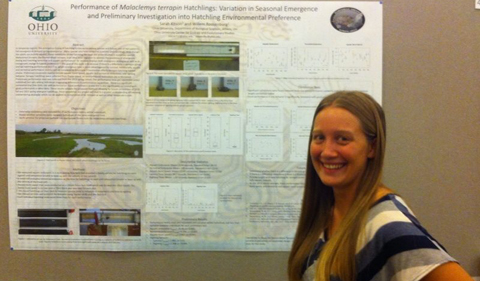Biological Sciences student Sarah Kitson presented a paper on “Performance of Malaclemys terrapin Hatchlings: Variation in Seasonal ” at the 2014 Joint Meeting of Ichthyologists and Herpetologists July 30 to Aug. 4 in Chattanooga, TN.
Her co-author was Dr. Willem Roosenburg, Professor of Biological Sciences at Ohio University.
Abstract: In temperate regions, the emergence timing of hatchling turtles varies among species and generally follows one of two patterns: fall emergence or delayed spring emergence. Many species also have terrestrial juveniles and hatchlings, even though the adults are entirely aquatic. These tendencies of the hatchling life stage are under-studied in numerous species. Malaclemys terrapin, the Diamondback terrapin, is an ideal focal organism to address the questions involved with both of these systems. M. terrapin displays both emergence strategies as well as an ontogenetic change in habitat preference. The goal of this study is to discover if there is a difference in terrapin spring and fall hatchling performance and if so, which emergence time is more advantageous for survival. In addition, aquatic and terrestrial performance metrics will be compared to determine if locomotion takes part in terrapin hatchling habitat choice. Locomotor metrics include aquatic and terrestrial burst speed, aquatic and terrestrial speed through cord grass, Spartina spp., aquatic and terrestrial endurance, and righting behavior. Physiological performance includes water loss rates, respiratory recovery after exhaustion, and shell strength. Terrapin hatchlings will be collected from Poplar Island, an environmental restoration site in Maryland. Preliminary performance data will be collected from the 2013 spring cohort. I will evaluate performance metrics that will be used to refine methodology for 2014 data collection. Our project will lead to a greater understanding of hatchling ecology which can be applied to conservation of the study species, M. terrapin, as well as other temperate turtles.



















Comments